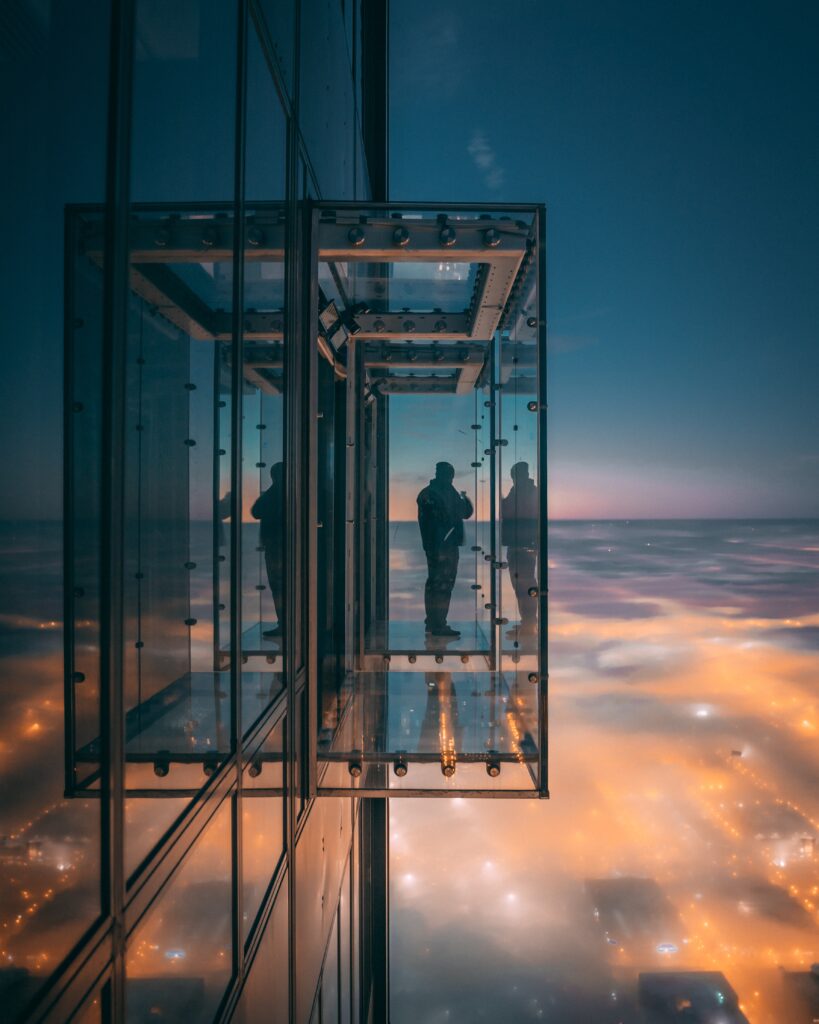Urban glass decor has evolved into a captivating expression of artistic ingenuity, and mirrors play a pivotal role in shaping the narrative of cityscapes. From their functional origins to becoming symbolic elements in modern urban environments, mirrors have undergone a fascinating transformation.

Introduction
In the bustling world of urban aesthetics, mirrors have emerged as silent storytellers, capturing the essence of city life in their reflective surfaces. This article delves into the historical evolution, artistry, and contextual significance of mirrors in urban glass decor, exploring their role as dynamic elements that engage and intrigue.
Historical Evolution of Mirrors in Urban Decor
Early Use of Mirrors in Urban Settings
The incorporation of mirrors in urban settings dates back to ancient civilizations. Mirrors initially served functional purposes, enhancing visibility and providing practical solutions for daily life.
Transition from Functional to Decorative Purposes
Over time, mirrors transcended their utilitarian roots, transforming into decorative elements that contributed to the visual richness of urban spaces. The shift from functionality to aesthetics marked a turning point in the use of mirrors in city decor.
Influence of Different Cultures on Urban Mirror Decor
Different cultures have left their imprint on urban mirror decor. Each cultural influence has contributed unique perspectives, resulting in a diverse tapestry of mirror installations that define the character of various cities.
The Artistry Behind Urban Glass Decor
Modern Trends in Incorporating Mirrors
Contemporary urban glass decor embraces modern trends, with mirrors being used in innovative ways. From large-scale installations to subtle accents, mirrors add a layer of sophistication to the urban landscape.
Impact of Architecture on Mirror Placement
Architectural designs heavily influence the placement of mirrors in urban environments. The strategic integration of mirrors enhances spatial dynamics and creates visually stunning compositions.
Fusion of Technology and Artistic Expression
The intersection of technology and artistic expression has given rise to dynamic mirror installations. Interactive mirrors, responsive to environmental cues, bring a new dimension to urban glass decor.
Mirrors as Reflective Storytellers
Mirrors Capturing the Essence of the City
Mirrors, strategically placed, capture the pulse of the city. They reflect the movement, vibrancy, and energy, creating a visual narrative that mirrors the dynamic nature of urban life.
Symbolism and Narrative in Urban Mirror Installations
Beyond their reflective function, mirrors often carry symbolism and narrative. Urban mirror installations become a canvas for artists to convey stories, connecting with the collective consciousness of the city.
Integration of Mirrors with Public Spaces
Public spaces are transformed into immersive experiences through the integration of mirrors. Parks, plazas, and urban squares become stages where mirrors interact with the surroundings and the people within them.
Perplexity in Urban Glass Decor
Creating Visual Complexity Through Mirrors
Perplexity in urban glass decor is achieved by creating visual complexity through mirrors. Intricate patterns, multiple reflections, and overlapping images contribute to an aesthetically rich and intriguing environment.
Balancing Chaos and Order in Mirror Designs
The juxtaposition of chaos and order is an art form in urban mirror decor. Skillful design strikes a delicate balance, ensuring that the complexity of reflections does not lose its underlying sense of order.
Burstiness in Urban Glass Decor
Mirrors as Dynamic Elements in City Aesthetics
Burstiness in urban glass decor is embodied by the dynamic nature of mirrors. Mirrors, as dynamic elements, introduce bursts of visual interest, breaking away from static design norms.
Incorporating Unconventional Shapes and Designs
Breaking away from conventional forms, urban mirror decor embraces burstiness through unconventional shapes and designs. Mirrors become focal points, challenging traditional perceptions of city aesthetics.
Specificity in Urban Mirror Installations
Tailoring Mirrors to Reflect City-Specific Themes
Cities are unique, and mirror installations are tailored to reflect the specific themes of each city. Whether it’s historical narratives, cultural nuances, or contemporary challenges, mirrors become customized expressions of urban identity.
Collaboration Between Artists and Urban Planners
Achieving specificity requires collaboration between artists and urban planners. This synergy results in mirror installations that seamlessly integrate with the urban fabric while adding distinctive character.

Contextual Significance of Urban Mirrors
Reflecting the Cultural Identity of the City
Mirrors serve as reflections not just of light but also of the cultural identity of the city. Urban mirror installations become a means of expressing and preserving the unique essence of a community.
Mirrors as a Response to Urban Challenges and Triumphs
In the face of urban challenges, mirrors stand as symbols of resilience and triumph. They reflect the city’s ability to adapt, evolve, and overcome obstacles, embodying the spirit of urban resilience.
Engaging the Reader Through Urban Glass Decor
Interactive Mirror Installations in Public Spaces
Engaging the reader involves interactive mirror installations in public spaces. Mirrors that respond to touch, movement, or sound encourage active participation, turning observers into participants in the urban narrative.
Encouraging Viewer Participation and Interpretation
The true engagement lies in encouraging viewer participation and interpretation. Urban mirror decor invites people to interpret the reflections, fostering a sense of connection and personal engagement with the urban environment.
The Active Voice of Urban Mirrors
Mirrors Influencing the Atmosphere of Urban Environments
Mirrors actively influence the atmosphere of urban environments. They can amplify light, create illusions of space, and contribute to the overall ambiance, shaping the way people perceive and experience the city.
Capturing the Vibrancy and Energy of City Life
The active voice of urban mirrors lies in capturing the vibrancy and energy of city life. Mirrors become dynamic canvases that reflect the ever-changing urban landscape, mirroring the vitality of the community.
Analogies and Metaphors in Urban Mirror Art
Mirrors as Metaphors for Self-Reflection
Analogies and metaphors abound in urban mirror art. Mirrors become symbolic of self-reflection, inviting individuals to contemplate their roles within the larger urban narrative.
Connecting Urban Mirror Installations to Broader Societal Themes
Urban mirror installations extend beyond mere aesthetics, connecting to broader societal themes. They serve as metaphors for unity, diversity, and the interconnectedness of the urban community.
Keeping it Simple in Urban Mirror Designs
Minimalistic Approaches to Mirror Decor
In the complexity of urban environments, simplicity stands out. Minimalistic approaches to mirror decor bring a sense of elegance and sophistication, allowing mirrors to seamlessly integrate into diverse urban settings.
Achieving Elegance Through Simplicity
Elegance is achieved through simplicity in urban mirror designs. The ability to convey profound messages with minimalistic elements underscores the power of restraint in urban glass decor.
Incorporating Rhetorical Questions in Urban Glass Decor
Prompting Contemplation Through Mirror Installations
Rhetorical questions become powerful tools in urban glass decor. Mirrors, strategically accompanied by questions, prompt contemplation, encouraging viewers to reflect not just on the mirrors but on the city itself.
Inviting Viewers to Ponder the City’s Reflection
The use of rhetorical questions extends an invitation to viewers to ponder the city’s reflection. This engagement creates a dialogue between the observer and the urban environment, fostering a deeper connection.

Urban Mirror Decor and Personal Pronouns
Mirrors as a Personal and Communal Experience
Urban mirror decor becomes a personal and communal experience. Mirrors reflect not only individual perspectives but also the collective identity of the community, creating a shared narrative.
Connecting the Individual to the Broader Urban Narrative
In the reflection of mirrors, individuals find a connection to the broader urban narrative. Mirrors serve as mirrors not only of light but of shared experiences, linking the personal to the communal.
Conclusion
In conclusion, mirrors play an integral role in shaping the narrative of urban glass decor. From historical evolution to modern trends, mirrors have become more than just reflective surfaces; they are dynamic elements that engage, captivate, and tell the ever-evolving story of the city.
FAQs
- Are urban mirror installations only for aesthetic purposes? Urban mirror installations serve a dual purpose, encompassing both aesthetic and symbolic dimensions. While they undoubtedly contribute to the visual appeal of urban environments, their significance goes beyond mere aesthetics. Mirrors become symbolic elements reflecting the cultural identity of the city. They encapsulate the history, values, and diversity of the community, turning each installation into a visual narrative of the city’s identity.
- How do mirrors in public spaces engage viewers actively? Mirrors in public spaces are designed to actively engage viewers through interactivity. Advanced mirror technologies allow for responsiveness to touch, movement, or sound. This interaction transforms passive observers into active participants, creating an immersive experience. Whether it’s through responsive installations that change with the viewer’s movement or mirrors that react to external stimuli, the goal is to foster a dynamic and participatory relationship between the viewer and the urban environment.
- What is the significance of mirrors in reflecting cultural identity? Mirrors play a crucial role in reflecting the cultural identity of a city. Beyond their reflective function, mirrors become mirrors of the city’s soul, capturing and preserving its unique essence. The designs, patterns, and themes incorporated into mirror installations often draw inspiration from the city’s history, traditions, and cultural symbols. In doing so, mirrors become not just decorative elements but storytellers, conveying the rich tapestry of the city’s cultural heritage.
- Can minimalistic mirror designs make a significant impact in urban environments? Minimalistic mirror designs have the power to make a profound impact on urban environments. In the complexity of bustling cityscapes, simplicity stands out. Minimalistic mirror designs bring a sense of elegance and sophistication, allowing mirrors to seamlessly integrate into diverse urban settings without overwhelming the visual landscape. The subtlety of minimalistic designs enhances the overall aesthetic appeal while maintaining a harmonious balance with the surrounding environment.
- How do mirrors serve as metaphors for self-reflection in urban settings? Mirrors in urban settings become powerful metaphors for self-reflection on both individual and communal levels. Beyond the literal act of reflecting physical appearances, mirrors invite individuals to contemplate their roles within the broader urban narrative. They encourage introspection and self-awareness, fostering a connection between the personal experiences of individuals and the collective identity of the urban community. Mirrors thus become portals for deeper contemplation and self-discovery within the context of the city.
Feel free to reach out if you have any more questions or if there’s anything else you’d like to explore!
